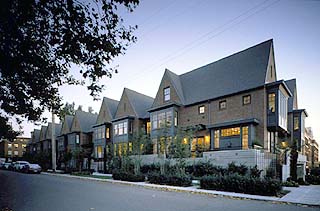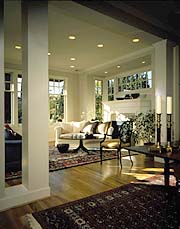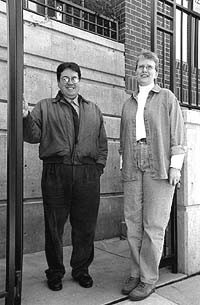|
Subscribe / Renew |
|
|
Contact Us |
|
| ► Subscribe to our Free Weekly Newsletter | |
| home | Welcome, sign in or click here to subscribe. | login |
Architecture & Engineering
| |
May 3, 2000
Project of the Month: Keeping company on Queen Anne
Special to the Journal
Walking along Comstock Street on the south crest of Queen Anne Hill is a lot more interesting this year, thanks to a smart new condominium building just across from St. Anne School.

|
|
Project:
Owner:
Architect:
Completion date:
Project type:
Project size:
Structural and civil engineer:
Landscape Architect:
Interior Design:
General contractor: |
And it couldn't have found more supportive neighbors. As a test of the city's new design review process, both the project and the process passed with flying colors. The code would have allowed two rather massive multi-story buildings, set back from the street. Instead, the owner applied for no less than seven departures from the building code, including lot coverage, length on the street front, set back and open space. All were heartily approved.
"We knew that what we wanted to do was appropriate," said Bodoia. And he knew the neighbors would like it.
Taking advantage of the sloping site, the architects sunk one level of the parking garage so that it was completely below grade at the street. Another, partially buried level of parking was added on top. The parking is accessed at the back of the town houses and through the center of the block, leaving the entire front free of curb cuts. The town house building is essentially a wall along the street, a building code no-no. Those who know older cities need no proof, but with the Victoria Townhomes, the architect has shown that a wall can be very interesting and inviting, indeed. The design team has orchestrated an intricate play between individual units and the street. The articulation of the residential units begins with the steep peaks of the gabled roof, which sets up a lively rhythm along the length and around the sides of the building.

|
Shrubbery softens the concrete base of the building at the street level, and beds of greenery enliven the planting strip. A concrete pathway along the curb extends presence and hospitality of the town houses to cars parked along the street.
With the advice of his project manager, Carol Hanson, Lorig invested in the quality of materials in each built-out unit and endorsed a series of design decisions that added substantially to the character and livability of the townhouses. There is a fireplace in every three-bedroom, two-and-one-half bath unit. Interiors have 10-foot-high ceilings and 8-foot doors, and there is no shortage of turns and moldings in the living areas or stainless and tile in the kitchens.

|
Sometimes it's better to look beyond the development potential and the dictates of the building code, and let the site be the guide. With Victoria Townhomes, what started out as a constraint was made into an opportunity. And everyone involved, from owner to buyers to neighbors, is a winner.
The Project of the Month feature is sponsored by the Daily Journal of Commerce and the Seattle chapter of the American Institute of Architects. Design categories include all types of construction with the exception of single-family houses. Projects are selected by distinguished architects, other members of the arts and design communities and representatives of client groups.
For more information about submitting projects for possible feature articles, contact Peter Sackett at AIA Seattle.
Clair Enlow can be reached by e-mail at clair@clairenlow.com.
Previous columns:
- Project of the Month: A livable law school at Seattle University, 03-01-2000
- Project of the Month: Old Ford plant gets a new engine, 02-02-2000
- New life for a landmark, 01-05-2000
- Renovation charts a new course, 09-01-1999
- Designed to transport, 07-01-1998


